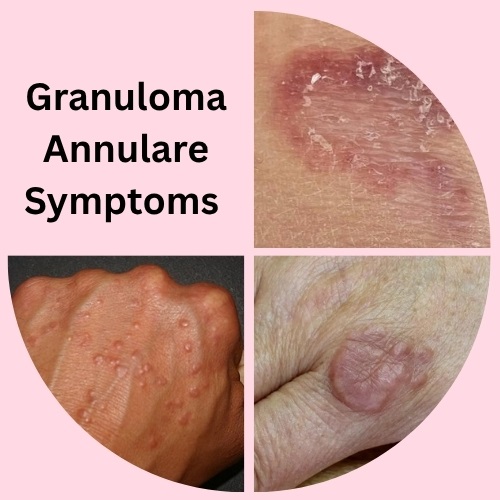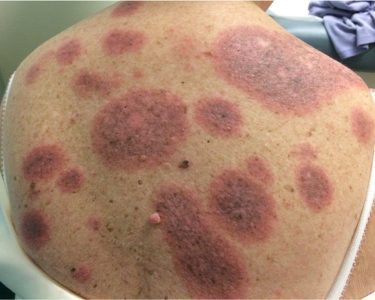Recognising Granuloma Annulare Symptoms
Granuloma annulare is a skin condition that typically causes ring-shaped lesions. These may appear harmless at first, but understanding the key signs can help you manage the condition more effectively. The most common symptoms of granuloma annulare include small, firm bumps on the skin that gradually form circular or semicircular patterns. These usually appear on the hands, feet, elbows, or knees.
Some people notice the rash feels smooth and may be slightly raised, but not painful. There’s usually no itching, which can make it harder to notice. However, if you’re seeing changes in your skin that follow this pattern, it’s worth investigating further.
Related Articles: What Causes Granuloma Annulare and How to Manage Flare-Ups
Symptoms of Granuloma Annulare by Type
Granuloma annulare can present in several different forms, each with slightly different symptoms:
1. Localised Granuloma Annulare
This is the most common type. You’ll usually see one or more small rings of skin-coloured or slightly red bumps. These often stay confined to one area of the body, such as the backs of the hands or feet.
2. Generalised or Disseminated Granuloma Annulare Symptoms
This form is less common and usually affects adults. You may notice widespread patches across the trunk, arms, and legs. Unlike the localised type, these can be itchy or uncomfortable. People often confuse disseminated granuloma annulare symptoms with other skin conditions such as eczema or psoriasis due to the broader spread.
3. Subcutaneous Granuloma Annulare Symptoms
This type usually affects children. The symptoms include firm, painless lumps under the skin, often around joints such as the knees or elbows. These do not form the ring shapes seen in other types, which can make them harder to identify as granuloma annulare.
Diabetes and Granuloma Annulare Symptoms
Granuloma annulare is generally a benign and self-limiting condition, but in some cases, especially when it becomes widespread or chronic, it may be associated with type 1 or type 2 diabetes. People with diabetes are more likely to develop the generalized form of granuloma annulare, which involves multiple areas of the body.
Common Symptoms of Granuloma Annulare
1. Skin Lesions
- Appearance:Ring-shaped or circular raised bumps.
- Color:Can be flesh-toned, red, or pink.
- Texture:Smooth and firm to the touch.
2. Location of Lesions
- Most often found on:
- Backs of hands
- Feet
- Elbows
- Knees
- In generalized GA (commonly linked with diabetes), lesions may appear on multiple body areas.
3. Itching or Irritation
- Usually not painful, but some individuals may experience mild itchingor tenderness.
4. Slow Healing
- Lesions may persist for months or years, especially in those with underlying health issues like diabetes.
Diabetes Symptoms to Watch For
People with granuloma annulare — especially the generalized type — should be aware of potential symptoms of undiagnosed or poorly controlled diabetes:
1. Increased Thirst and Urination
- Frequent urination and feeling constantly thirsty.
2. Fatigue
- Ongoing tiredness or lack of energy.
3. Blurred Vision
- Changes in eyesight due to high blood sugar.
4. Unexplained Weight Loss
- Losing weight without a change in diet or exercise.
5. Slow-Healing Wounds
- Cuts and sores that take a long time to heal — a common issue in diabetics.
When to Seek Medical Advice
Granuloma annulare often resolves on its own without treatment, especially in mild cases. However, if the rash is spreading, painful, or affecting your quality of life, seek medical support. In some cases, a biopsy or blood tests may be needed to confirm the diagnosis, particularly if other symptoms suggest an underlying condition like diabetes.
Related Articles: What is the Best Treatment for Granuloma Annulare?
If you’re noticing changes in your skin and think they may match granuloma annulare – symptoms, don’t ignore them. Early detection can lead to better symptom management and peace of mind.
Final Thoughts
Whether you’re seeing early signs or dealing with a long-standing skin issue, being aware of the typical symptoms of granuloma annulare can help you decide what steps to take next. Knowing the difference between the localised and disseminated granuloma annulare symptoms is especially important, particularly if you also have other health concerns such as diabetes.
For more on how this condition can affect you, read our detailed article on diabetes granuloma annulare symptoms.




